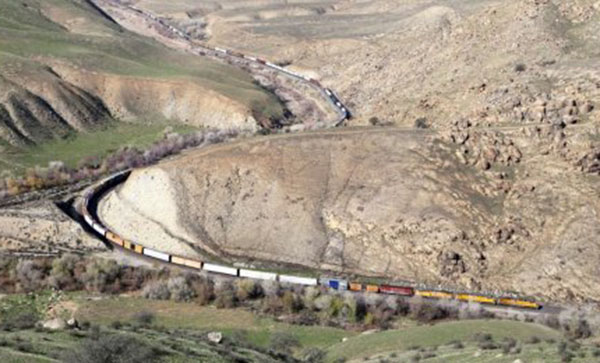Critical to the future growth of Los Angeles and the state of California, the rail line was completed in record time despite many engineering challenges.
The Tehachapi Railroad Line was built from 1874 to 1876 to connect California’s fertile San Joaquin Valley with the then small agricultural town of Los Angeles on California’s southern coast. Originally Southern Pacific, the company which nearly monopolized railroad transportation in California at that time, wanted the Tehachapi Line to bypass Los Angeles and instead go southeast through the Mojave Desert to Yuma, Arizona, and all points east. Ultimately state politics trumped SP’s desires and Los Angeles’ bright future was cast in railroad steel.
Construction of the Tehachapi
The Tehachapi Railroad Line was the work of two talented civil engineers, William Hood and his chief of construction, J.B. Harris, both of who worked for Southern Pacific Railroad. The construction route extended south from Sacramento to the town of Caliente, just south of Bakersfield.
As is normal in locating railroad lines, the Tehachapi followed the gentle grades of creeks like Caliente Creek as it made its way into the foothills of the mountains. There the two engineers encountered the challenge of getting the railroad over the steep Tehachapi mountains which form the southern end of the Sierra Nevada Mountain Range. They chose a route across Tehachapi Pass which, at 4,025 feet elevation, is the lowest pass across the Sierras and remains nearly snow-free in the winter.
The Tehachapi Loop
Considered an engineering and construction marvel in its day, the Tehachapi Railroad follows the steep Tehachapi Creek, averaging a 2.2 percent grade over 28 miles. In order to do this the railroad line makes a series of twists, curves, and turns that includes passes through six tunnels. The track finally gains an additional 90 feet of elevation as it dramatically spirals over itself at the Tehachapi Loop.
Most of the work to complete the railroad was done by laborers known as “coolies” who came to the United States from Canton, China. As many as 3,000 of these Chinese laborers worked with picks, shovels, and dynamite to remove the granite rock of the mountains and haul it away in horse-drawn carts. Under the direction of Harris and Hood the entire Tehachapi Railroad Line was completed in less than two years, an amazing feat considering the complexity of the project.
The Busiest Railroad Line
Today the Tehachapi Railroad Line is in constant use and boasts being the busiest run of single-track railroad in North America. The track is basically unchanged from its construction over 130 years ago and sees an average of 36 railroad trains rumbling over its tracks every day. Trains using the tracks are still limited to 30 miles per hour as they travel the Loop and must pull over to sidings several times on the journey to avoid oncoming trains.
If you’re ever driving state highway 58 that winds its way over the Tehachapi Mountains you can look over to see the lines of cars making their stately way across this famous rail line.
Source:
- All information courtesy of the San Diego Model Railroad Museum, located in Balboa Park, San Diego.








